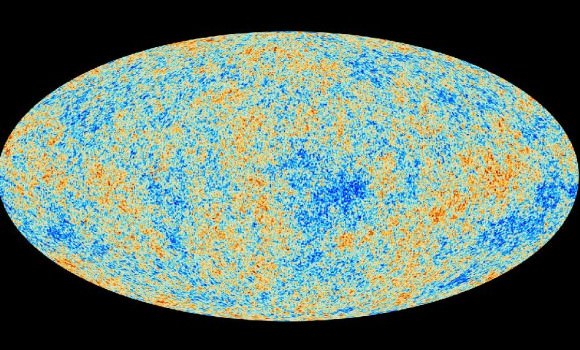Earlier this year, a new map of the Cosmic Microwave Background from the Planck spacecraft revealed our Universe was a bit older and is expanding a tad more slowly that previously thought. Additionally, there are certain large scale features that cosmologists cannot readily explain. In fact, because of this finding — possible because of the Planck satellite — we may need to modify, amend or even fundamentally change our description of the Universe’s first moments.
Today, July 31, at 19:00 UTC (12:00 p.m. PDT, 3:00 pm EDT) the Kavli Foundation is hosting a live Google+ Hangout: “A New Baby Picture of the Universe.” You can watch in the player embedded below. You’ll have the chance to ask your questions to Planck scientists by posting on Twitter with the hashtag #KavliAstro, or by email to [email protected]. Questions can be sent prior and during the live webcast. If you miss it live, you can watch the replay here, as well.
You will hear from three leading members of the Planck research team — George Efstathiou and Anthony Lasenby of the Kavli Institute for Cosmology at the University of Cambridge, and Krzysztof Gorski, Senior Research Scientist at the Jet Propulsion Laboratory in Pasadena, CA and faculty member at the Warsaw University Observatory in Poland — and they’ll answer your questions about what was found and what this means to our understanding of the universe.
See the Kavli Foundation page for this event for more details.


Umm, is it just me? or did it seem to you that the participants just didn’t want to talk multiverse… no. Funny that theory states that the CMB would show where the interface between our universe and the next one over is, as a hole or void in the CMB!.
Yes… Taka a look at the Dec. 3 2012 issue of Sky and Telescope mag. Specifically the article entitled “Cosmic Collisions” by Camille M. Carlisle. Using WMAP data of the mircrowave background researchers did NOT see enough evidence in the random fluctuations colliding universes would impart on the CMB. Now, with Planck’s much higher fidelity mapping combined with new and improved algorithms definitelly shows the ‘cold spot’ as hinted at in the WMAP data is indeed a very real phenomena. Skepticism abounds because this IS a game changing observation.. and apparently no body wants to be the first to ‘dive in’? I will though… Welcome to the multiverse!
One has to carefully see if this dark anomaly conforms to the predictions of the multiverse. This could be due to the interactions between our bubble nucleation region with anoher in the inflationary spacetime. One must be very careful though to not leap to conclusions prematurely.
LC
“..foreground microwave sources from objects that aren’t known and haven’t been predicted.” sounds interesting too!
As a circular feature, actually. There were 4 candidates before Planck. Sean Carroll on Cosmic Variance has a guest post on that research from a guest blogger. http://www.preposterousuniverse.com/blog/2010/12/22/observing-the-multiverse-guest-post/
“Our philosophy was to define a phenomenological model that encompasses the generic signatures of bubble collisions, and use the data to constrain the free parameters in the model.”
“We did not find any circular temperature discontinuities in the WMAP data.
While we didn’t make any clear detections of bubble collisions, we did find four features in the WMAP data that are better explained by the bubble collision hypothesis than by the standard hypothesis of fluctuations in a nearly Gaussian field. We assess which of the two models better explain the data by evaluating the Bayesian evidence for each. ”
I said elsweher that the CS wasn’t one of the candidates, but I see now its wrong.